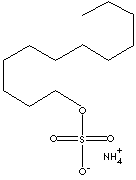Formula C12H29NO4S Density 1.02 g/cm³ | Molar mass 283.43 g/mol Appearance yellowish viscous liquid | |
 | ||
Ammonium lauryl sulfate (ALS) is the common name for ammonium dodecyl sulfate (CH3(CH2)10CH2OSO3NH4). The molecule consists of a long nonpolar hydrocarbon chain and a polar sulfate end group, the combination of which make the material a surfactant. These two components allow the compound to dissolve among both polar and non-polar molecules. ALS is classified as an alkyl sulfate and is an anionic surfactant found primarily in shampoos and body-wash as a foaming agent. Lauryl sulfates are very high-foam surfactants that disrupt the surface tension of water in part by forming micelles around the highly polar water molecules at the surface-air interface.
Contents
Action in solution
Like many surfactants, ammonium lauryl sulfate makes a good base for cleaners because of the way it disrupts hydrogen bonding in water. (It is hydrogen bonding that is the primary contributor to the high surface tension of water.) In aqueous (water-based) solutions, the lauryl sulfate anions and the ammonium cations dissociate from each other. Above the critical micelle concentration, the anions then align themselves into a micelle, in which they form a sphere with the polar, hydrophilic heads of the sulfate portion on the outside (surface) of the sphere and the nonpolar, hydrophobic tails pointing inwards towards the center. The water molecules around the micelle in turn arrange themselves around the polar heads, which disrupts their ability to hydrogen bond with other nearby water molecules. The overall effect of these micelles is a reduction in surface tension of the solution, which affords a greater ability to penetrate or "wet out" various surfaces, including porous structures like cloth, fibers, and hair. Accordingly, this allows the solution to more readily dissolve soils, greases, etc. in and on such substrates.
Safety
In high concentrations this molecule may cause severe irritation to eyes and skin. Inhalation may cause irritation to the respiratory system. Ingestion may cause irritation.
In a 1983 report by the Cosmetic Ingredient Review, shampoos containing up to 31% ALS registered 6 health complaints out of 6.8 million units sold. These complaints included two of scalp itch, two allergic reactions, one hair damage and one complaint of eye irritation.
The CIR report concluded that both sodium and ammonium lauryl sulfate “appear to be safe in formulations designed for discontinuous, brief use followed by thorough rinsing from the surface of the skin. In products intended for prolonged use, concentrations should not exceed 1%.”
The Human and Environmental Risk Assessment (HERA) project performed a thorough investigation of all alkyl sulfates, as such the results they found apply directly to ALS. Most alkyl sulfates exhibit low acute oral toxicity, no toxicity through exposure to the skin, concentration dependent skin irritation, and concentration dependent eye-irritation. They do not sensitize the skin and did not appear to be carcinogenic in a two-year study on rats. The report found that longer carbon chains (16–18) were less irritating to the skin than chains of 12–15 carbons in length. In addition, concentrations below 1% were essentially non-irritating while concentrations greater than 10% produced moderate to strong irritation of the skin.
Occupational exposure
The CDC has reported on occupations which were routinely exposed to ALS between 1981 and 1983. During this time, the occupation with the highest number of workers exposed was registered nurses, followed closely by funeral directors.
Environment
The HERA project also conducted an environmental review of alkyl sulfates that found all alkyl sulfates are readily biodegradable and standard wastewater treatment operations removed 96–99.96% of short-chain (12–14 carbons) alkyl sulfates. Even in anaerobic conditions at least 80% of the original volume is biodegraded after 15 days with 90% degradation after 4 weeks.
